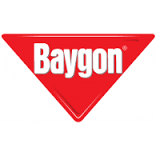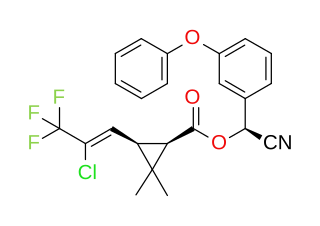
Insecticides are pesticides used to kill insects. They include ovicides and larvicides used against insect eggs and larvae, respectively. Insecticides are used in agriculture, medicine, industry and by consumers. Insecticides are claimed to be a major factor behind the increase in the 20th-century's agricultural productivity. Nearly all insecticides have the potential to significantly alter ecosystems; many are toxic to humans and/or animals; some become concentrated as they spread along the food chain.

Cypermethrin (CP) is a synthetic pyrethroid used as an insecticide in large-scale commercial agricultural applications as well as in consumer products for domestic purposes. It behaves as a fast-acting neurotoxin in insects. It is easily degraded on soil and plants but can be effective for weeks when applied to indoor inert surfaces. Exposure to sunlight, water and oxygen will accelerate its decomposition. Cypermethrin is highly toxic to fish, bees and aquatic insects, according to the National Pesticides Telecommunications Network (NPTN). It is found in many household ant and cockroach killers, including Raid, Ortho, Combat, ant chalk, and some products of Baygon in Southeast Asia.

Piperonyl butoxide (PBO) is a pale yellow to light brown liquid organic compound used as a synergist component of pesticide formulations. That is, despite having no pesticidal activity of its own, it enhances the potency of certain pesticides such as carbamates, pyrethrins, pyrethroids, and rotenone. It is a semisynthetic derivative of safrole.
Roach bait is a modern pest control used for the extermination of cockroaches at indoor locations. The effectiveness of this method of pest control exploits the cannibalistic and coprophagic tendencies of cockroaches.

The pyrethrins are a class of organic compounds normally derived from Chrysanthemum cinerariifolium that have potent insecticidal activity by targeting the nervous systems of insects. Pyrethrin naturally occurs in chrysanthemum flowers and is often considered an organic insecticide when it is not combined with piperonyl butoxide or other synthetic adjuvants. Their insecticidal and insect-repellent properties have been known and used for thousands of years.

Bifenthrin is a pyrethroid insecticide. It is widely used against ant infestations.

A pyrethroid is an organic compound similar to the natural pyrethrins, which are produced by the flowers of pyrethrums. Pyrethroids are used as commercial and household insecticides.

Permethrin is a medication and an insecticide. As a medication, it is used to treat scabies and lice. It is applied to the skin as a cream or lotion. As an insecticide, it can be sprayed onto outer clothing or mosquito nets to kill the insects that touch them.

Fipronil is a broad-spectrum insecticide that belongs to the phenylpyrazole chemical family. Fipronil disrupts the insect central nervous system by blocking the ligand-gated ion channel of the GABAA receptor and glutamate-gated chloride (GluCl) channels. This causes hyperexcitation of contaminated insects' nerves and muscles. Fipronil's specificity towards insects is believed to be due to its greater binding affinity for the GABAA receptors of insects than to those of mammals, and for its action on GluCl channels, which do not exist in mammals. As of 2017, there does not appear to be significant resistance among fleas to fipronil.

Resmethrin is a pyrethroid insecticide with many uses, including control of the adult mosquito population.

Mortein is an Australian brand of household insecticide owned by the British company Reckitt. Together with its sister product Aerogard, a popular insect repellent, Mortein is widely used in Australia and is marketed internationally. It is also available in New Zealand, India, Pakistan, Fiji, and the Comoros. The brand has been represented in television commercials by cartoon antagonist Louie the Fly.

Phenothrin, also called sumithrin and d-phenothrin, is a synthetic pyrethroid that kills adult fleas and ticks. It has also been used to kill head lice in humans. d-Phenothrin is used as a component of aerosol insecticides for domestic use. It is often used with methoprene, an insect growth regulator that interrupts the insect's biological lifecycle by killing the eggs.

Baygon is a pesticide brand produced by S. C. Johnson & Son. It is an insecticide used for extermination and control of household pests such as crickets, roaches, ants, carpenter ants, spiders, silverfish and mosquitoes. In 1975, Baygon introduced Australia’s first surface spray for killing cockroaches, ticks and other crawling insects.

Bendiocarb is an acutely toxic carbamate insecticide used in public health and agriculture and is effective against a wide range of nuisance and disease vector insects. Many bendiocarb products are or were sold under the tradenames "Ficam" and "Turcam."

Cyhalothrin is the ISO common name for an organic compound that, in specific isomeric forms, is used as a pesticide. It is a pyrethroid, a class of synthetic insecticides that mimic the structure and properties of the naturally occurring insecticide pyrethrin which is present in the flowers of Chrysanthemum cinerariifolium. Pyrethroids such as cyhalothrin are often preferred as an active ingredient in agricultural insecticides because they are more cost-effective and longer acting than natural pyrethrins. λ-and γ-cyhalothrin are now used to control insects and spider mites in crops including cotton, cereals, potatoes and vegetables.

Prallethrin is a pyrethroid insecticide. Prallethrin 1.6% w/w liquid vaporizer is a repellent insecticide which is generally used for the control of mosquitoes in the household.

Imiprothrin is a synthetic pyrethroid insecticide. It is an ingredient in some commercial and consumer insecticide products for indoor use. It has low acute toxicity to humans through the inhalation and dermal routes, but to insects it acts as a neurotoxin causing paralysis. It is effective against cockroaches, waterbugs, ants, silverfish, crickets and spiders, among others.

Tefluthrin is the ISO common name for an organic compound that is used as a pesticide. It is a pyrethroid, a class of synthetic insecticides that mimic the structure and properties of the naturally occurring insecticide pyrethrin which is present in the flowers of Chrysanthemum cinerariifolium. Pyrethroids such as tefluthrin are often preferred as active ingredients in agricultural insecticides because they are more cost-effective and longer acting than natural pyrethrins. It is effective against soil pests because it can move as a vapour without irreversibly binding to soil particles: in this respect it differs from most other pyrethroids.

Sulfoxaflor, also marketed as Isoclast, is a systemic insecticide that acts as an insect neurotoxin. A pyridine and a trifluoromethyl compound, it is a member of a class of chemicals called sulfoximines, which act on the central nervous system of insects.
Wasp dope refers to the ingestion of common household insecticides as a substitute for more conventional addictive substances that cause euphoria, such as methamphetamine or crack cocaine. Wasp dope is an emerging trend in the southern United States, although there are obscure reports of insecticide abuse dating back to the 1980s.


















